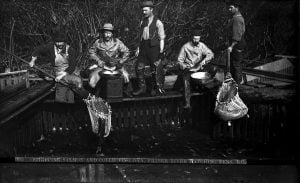
Wildlife
The great green shark hunt
Can British Columbia’s spiny dogfish make the grade as the world’s first “sustainable” shark fishery?
- 3319 words
- 14 minutes
This article is over 5 years old and may contain outdated information.
Wildlife

Asian carp, an invasive species, are migrating toward the Great Lakes and could one day become the most common fish in Lake Erie.
Here, Marc Gaden, communications director and legislative liaison for the Great Lakes Fishery Commission, explains some of the economic and ecological consequences of the species establishing itself in the Great Lakes.
On why this might be happening
Asian carp are invasive, and they’re trying to expand their range, just like invaders do. Lake Erie has plenty of food for Asian carp, which feed on plankton and would find the lake to be an inviting habitat in respect to water temperature.
On the effect this will have on other fish species in the lakes
These fish eat a lot, so they’re taking plankton out of the food web. Plankton is at the very base of the food web, and because carp reproduce in quite large numbers, they would compete with and out-compete other fish in the lake.
On the effects on people
People would be put in direct danger, particularly from the silver variety of the Asian carp. They are easily spooked and the sound of a boat motor is enough to scare these fish out of the water. Some of them can leap several metres into the air. If you’re in a boat that’s moving at 30 km/h and you come into contact with a flying fish, you’re going to loose that battle.
On what is being done
There’s a lot being done. It’s a rare opportunity we’ve had to take action prior to an invasion. There is fishing being done to remove carp. Four million pounds of carp have been caught, reducing the population by 68 per cent. There is intensive monitoring going on in the Chicago-area waterways to keep close tabs on where these fish are and what life stage they are at, so a proper response can be launched. If a carp is found where it shouldn’t be, a response can be mounted. There is also an electrical barrier in the Chicago area that’s designed to prevent the movement of fish from the Mississippi River to the Great Lakes. That barrier is the only thing that would prevent those fish from having a straight shot into Lake Michigan.
Are you passionate about Canadian geography?
You can support Canadian Geographic in 3 ways:

This story is from the April 2016 Issue

Wildlife
Can British Columbia’s spiny dogfish make the grade as the world’s first “sustainable” shark fishery?

History
From their beginnings in the late 19th century, salmon hatcheries have gone from cure to band-aid to crutch. Now, we can’t live without manufactured fish.

People & Culture
A moratorium on cod fishing that was supposed to last two years has now lasted 30. What will it take to rebuild cod stocks — and a way of life?

Wildlife
Wildlife names that could use a rebrand